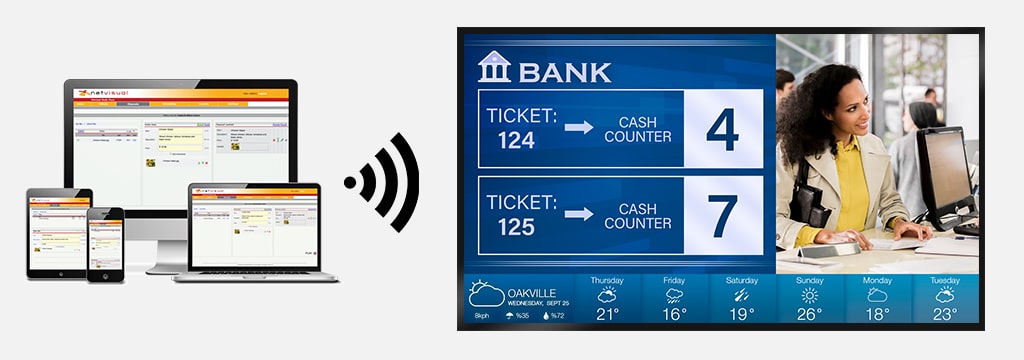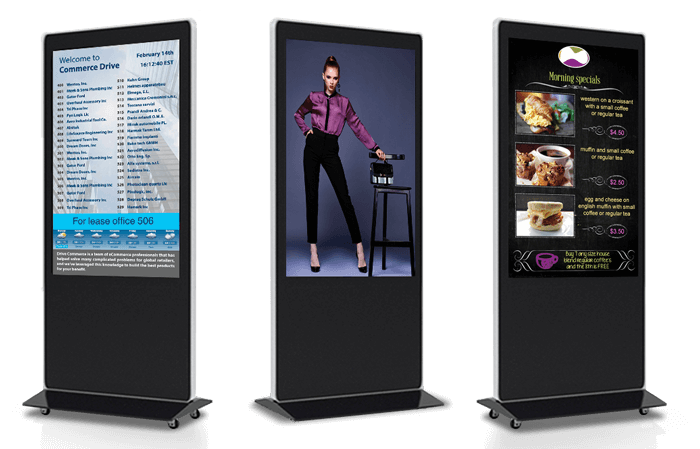In an era dominated by digital advancements, traditional methods of displaying information are giving way to innovative solutions that captivate and engage audiences. You may have heard the terms digital signage or electronic displays thrown around, but what exactly are they? Digital signage has become the standard method of marketing across many industries for good reason, and in this article we will explain exactly what it is.
What is Digital Signage?
Digital signage is an electronic display medium, or digital screen, used to display a variety of multimedia content including images and video. While the most common uses for digital signage installations are as digital directories, digital menu boards, and digital promotional screens, it has quickly become a business staple worldwide. To put it simply, digital signage is everywhere. The advertisements you see while waiting at the bus station, the digital screens at the movie theatre, and even where you get your gate information – these are all examples of digital signage.
As digital signage becomes an increasingly large part of our lives, both as business owners and as consumers, it is important to understand what it is and the role it plays. According to recent statistics, not only does digital signage reach 135 Million people a week, but more businesses than ever are adopting this technology than ever; 60% of enterprises without digital signage are planning to invest in the next two years. In an era where time is precious, the convenience, environmental benefits, and time and cost saving benefits are what make digital signage so attractive.

What is the Definition of Digital Signage?
Wikipedia defines digital signage as “a segment of electronic signage” and uses technologies such as ” LCD, LED, projection and e-paper to display digital images, video, web pages, weather data, restaurant menus, or text.”
Digital signage is typically comprised of 3 main components:
- Digital Signage Hardware: The physical components of your electronic signage, which can vary depending on medium and also maker. While some styles of signage may utilize commercial grade screens, others may use digital kiosks, interactive touch screen signage, or specially designed screens as well. In order to facilitate a network connection, digital signage hardware also typically includes a media player to receive and play your content.
- Digital Signage Software: This software is what enables the deployment, creation, editing, analysis, and scheduling of your content on your screens.
- Digital Signage Content: The content deployed on your digital signage, which can include a combination of images, video, text, audio, and more.
What are the Key Features of Digital Signage?
- Dynamic Content: Digital signage allows for the easy creation and display of dynamic content, which can include text, images, videos, and animations. This flexibility enables businesses to update and customize their messages quickly.
- Remote Management: Remote management is a service offered by digital signage providers which allows you to change, update, and schedule your content through an online portal.
- Interactivity: Some digital signage screens offer interactivity features, including touch screen capabilities that allow users to engage with their content. An example of this would be a mall or office building with touch screen wayfinding signage.
- Real-Time Information: Digital signage can display real-time information, such as news feeds, social media updates, weather forecasts, or live event schedules, providing relevant and timely content to your viewers.
- Cost-Effective Updates: Rather then printing new physical signage every time you need to make a change, digital signage allows you to make changes instantly and in a cost-effective manner.

What are the Types of Digital Signage?
Digital signage is a staple of modern businesses because the uses for this revolutionary technology are absolutely endless. Businesses across almost every industry worldwide have found their own uses for digital signage, however, here are some of the more popular ways to use digital signage screens.
- Digital Menu Boards
- Digital Building Directories
- Digital Informational Displays
- Digital Retail Signage
- Digital Video Walls
- Digital Wayfinding Signage
- Interactive Touch Screen Kiosks

Where is Digital Signage Used?
Digital signage is used in many industries worldwide, here are some of the more popular ones:
- Restaurants – Digital menu boards, promotional screens, interactive ordering kiosks
- Retail – Digital shelf edge screens, window facing promotional signage, in-store advertising
- Retirement and Long-Term Care – Digital wayfinding signage, meal and class schedules, in-room notice boards
- Funeral Homes – Wayfinding signage, funeral information displays, and in-funeral slideshows
- Cannabis Retailers – Promotional signage, shelf edge screens, and in store inventory display
- Corporate – Corporate communications, digital building directories, and more
- Automotive – Vehicle status updates, local weather and news updates, and ongoing promotions
- Education – Educational aids, cafeteria menu boards, wayfinding, library signage, and exhibitions
- Healthcare – Waiting room signage, patient news, and shelf screens for pharmacies and optometric clinics
- Churches and Religious Venues – Worship schedules, digital roadside signs, interactive displays during worship

Related Posts

Sustainable Solutions: How Digital Signage Helps American Businesses Go Green
As sustainability becomes an increasing priority for modern American businesses, many business owners are looking for innovative ways to reduce their carbon footprint and adopt eco-friendly practices. Digital signage offers a compelling

Adapting Digital Signage for Seasonal Campaigns and Holiday Promotions
The holidays are fast approaching, which means many businesses are gearing up for their holiday marketing campaigns, promotions, and initiatives. There are many ways to use digital signage for holiday

5 Ways to Use Outdoor Digital Signage
Outdoor digital signage has become extremely popular in recent years and for a very good reason. This incredible technology has seen numerous advancements that allow it to be a staple

The Future of Outdoor Digital Signage: Weatherproof Displays and Sustainability
The future of outdoor digital signage is increasingly shaped by two key trends: the need for weatherproof displays and the drive toward sustainability. These trends are driven by technological advances,

